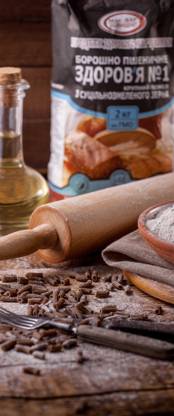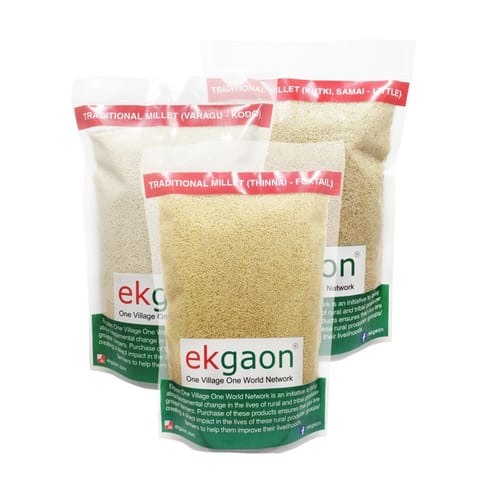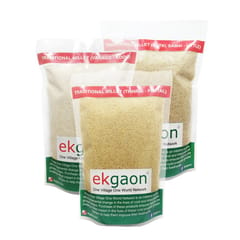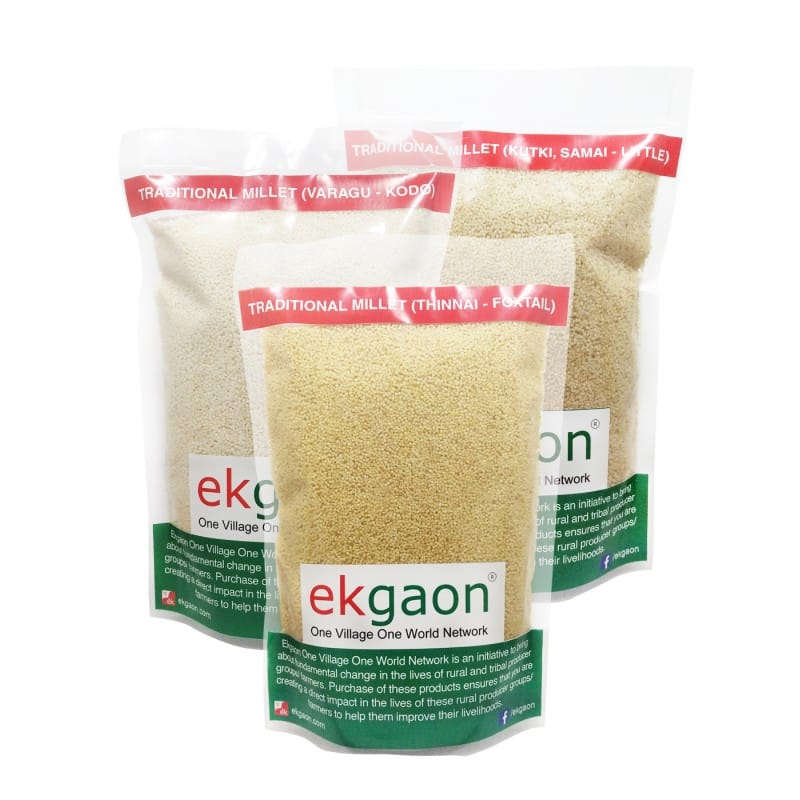This healthy traditional millet is combo of Kodo Millet, Foxtail Millet (Thinai), LIttle Millet (Kutki). Kodo millet is a nutritious grain and a good substitute to rice or wheat. The grain is composed of 11% of protein. High in Nutrition which is good for children to grow. Kodo millets also contain high amounts of polyphenols, an antioxidant compound. Millets are rich in B vitamins, especially niacin, B6 and folic acid. Millets contain no gluten.
Foxmillets (Foxtail) are high in calories, giving strength and energy for farmers to work actively in fields. Foxtail is a vegan food and also gluten free cereal. Foxtail is rich in proteins, and low in fat. It has good amount of fiber content, calcium, iron, potassium, magnesium and carbohydrates. It does not have sugar in any form so foxtail millet is a diabetic food. Unlike rice, foxtail millet releases glucose steadily without affecting the metabolism of the body.
Little millet was domesticated in India. The seeds of little millet are smaller than those of common millet. little millet are higher in fat, Little millet is a wonderful millet which is suitable for people of all age groups. It has a cooling effect on the body. Little Millet is cooked like rice. Sometimes the millet is also milled and baked. The protein content of the grain is 7.7%.
The largest cultivation is in central India. These look very similar to foxtail millet but are white in colour. It is grown throughout India and a traditional crop of Karnataka. It has received comparatively little attention from plant breeders. The plant varies in height between 30 and 90 cm and its oblong panicle varies in length between 14 and 40 cm. It is mostly mix cropped with other millets, pulses and oilseeds. The seeds of little millet are smaller than those of common millet. It is generally consumed as rice and any recipe that demands staple rice can be prepared using little millet.
SKU-W-V8UBDXIYTJ- Home
- Top Values
- Gluten Free
- Healthy Traditional Millets Combo 4 500 gms
Healthy Traditional Millets Combo 4 500 gms
- Kodo millet is controlling Blood sugar and Cholesterol.
- Great energy source especially good for athletes. Gluten-free – ideal for celiacs
- Diabetic patients and in women it could be a good idea for all periods and imaginary problems. Gluten-free – ideal for digestive and autoimmune disorder.
- It is helps to lower blood glucose levels and improves insulin response.
The product is at its best price.
- Easy Returns
- 100% Authentic Products
- Secure Payments
This healthy traditional millet is combo of Kodo Millet, Foxtail Millet (Thinai), LIttle Millet (Kutki). Kodo millet is a nutritious grain and a good substitute to rice or wheat. The grain is composed of 11% of protein. High in Nutrition which is good for children to grow. Kodo millets also contain high amounts of polyphenols, an antioxidant compound. Millets are rich in B vitamins, especially niacin, B6 and folic acid. Millets contain no gluten.
Foxmillets (Foxtail) are high in calories, giving strength and energy for farmers to work actively in fields. Foxtail is a vegan food and also gluten free cereal. Foxtail is rich in proteins, and low in fat. It has good amount of fiber content, calcium, iron, potassium, magnesium and carbohydrates. It does not have sugar in any form so foxtail millet is a diabetic food. Unlike rice, foxtail millet releases glucose steadily without affecting the metabolism of the body.
Little millet was domesticated in India. The seeds of little millet are smaller than those of common millet. little millet are higher in fat, Little millet is a wonderful millet which is suitable for people of all age groups. It has a cooling effect on the body. Little Millet is cooked like rice. Sometimes the millet is also milled and baked. The protein content of the grain is 7.7%.
The largest cultivation is in central India. These look very similar to foxtail millet but are white in colour. It is grown throughout India and a traditional crop of Karnataka. It has received comparatively little attention from plant breeders. The plant varies in height between 30 and 90 cm and its oblong panicle varies in length between 14 and 40 cm. It is mostly mix cropped with other millets, pulses and oilseeds. The seeds of little millet are smaller than those of common millet. It is generally consumed as rice and any recipe that demands staple rice can be prepared using little millet.
This healthy traditional millet is combo of Kodo Millet, Foxtail Millet (Thinai), LIttle Millet (Kutki). Kodo millet is a nutritious grain and a good substitute to rice or wheat. The grain is composed of 11% of protein. High in Nutrition which is good for children to grow. Kodo millets also contain high amounts of polyphenols, an antioxidant compound. Millets are rich in B vitamins, especially niacin, B6 and folic acid. Millets contain no gluten.
Foxmillets (Foxtail) are high in calories, giving strength and energy for farmers to work actively in fields. Foxtail is a vegan food and also gluten free cereal. Foxtail is rich in proteins, and low in fat. It has good amount of fiber content, calcium, iron, potassium, magnesium and carbohydrates. It does not have sugar in any form so foxtail millet is a diabetic food. Unlike rice, foxtail millet releases glucose steadily without affecting the metabolism of the body.
Little millet was domesticated in India. The seeds of little millet are smaller than those of common millet. little millet are higher in fat, Little millet is a wonderful millet which is suitable for people of all age groups. It has a cooling effect on the body. Little Millet is cooked like rice. Sometimes the millet is also milled and baked. The protein content of the grain is 7.7%.
The largest cultivation is in central India. These look very similar to foxtail millet but are white in colour. It is grown throughout India and a traditional crop of Karnataka. It has received comparatively little attention from plant breeders. The plant varies in height between 30 and 90 cm and its oblong panicle varies in length between 14 and 40 cm. It is mostly mix cropped with other millets, pulses and oilseeds. The seeds of little millet are smaller than those of common millet. It is generally consumed as rice and any recipe that demands staple rice can be prepared using little millet.
This healthy traditional millet is combo of Kodo Millet, Foxtail Millet (Thinai), LIttle Millet (Kutki). Kodo millet is a nutritious grain and a good substitute to rice or wheat. The grain is composed of 11% of protein. High in Nutrition which is good for children to grow. Kodo millets also contain high amounts of polyphenols, an antioxidant compound. Millets are rich in B vitamins, especially niacin, B6 and folic acid. Millets contain no gluten.
Foxmillets (Foxtail) are high in calories, giving strength and energy for farmers to work actively in fields. Foxtail is a vegan food and also gluten free cereal. Foxtail is rich in proteins, and low in fat. It has good amount of fiber content, calcium, iron, potassium, magnesium and carbohydrates. It does not have sugar in any form so foxtail millet is a diabetic food. Unlike rice, foxtail millet releases glucose steadily without affecting the metabolism of the body.
Little millet was domesticated in India. The seeds of little millet are smaller than those of common millet. little millet are higher in fat, Little millet is a wonderful millet which is suitable for people of all age groups. It has a cooling effect on the body. Little Millet is cooked like rice. Sometimes the millet is also milled and baked. The protein content of the grain is 7.7%.
The largest cultivation is in central India. These look very similar to foxtail millet but are white in colour. It is grown throughout India and a traditional crop of Karnataka. It has received comparatively little attention from plant breeders. The plant varies in height between 30 and 90 cm and its oblong panicle varies in length between 14 and 40 cm. It is mostly mix cropped with other millets, pulses and oilseeds. The seeds of little millet are smaller than those of common millet. It is generally consumed as rice and any recipe that demands staple rice can be prepared using little millet.
| VARIANT | SELLER | PRICE | QUANTITY |
|---|
Product Enquiry Form
Leave us a message for futher information.
SUBSCRIBE TO OUR NEWSLETTER
Thanks, You have now been subscribed to our newsletter.
Your response has been recorded.
Get news and offers delivered straight to your inbox. We promise to never spam.
- Facing Issues? Call us Mon-Fri between 11 AM - 7 PM
- +919830476761
www.onahealthynote.com























